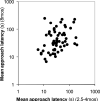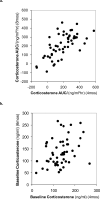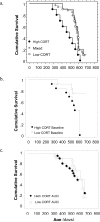Stable behavioral inhibition and glucocorticoid production as predictors of longevity
- PMID: 19477191
- PMCID: PMC2756444
- DOI: 10.1016/j.physbeh.2009.05.012
Stable behavioral inhibition and glucocorticoid production as predictors of longevity
Abstract
Several personality/temperament traits have been linked to health outcomes in humans and animals but underlying physiological mechanisms for these differential outcomes are minimally understood. In this paper, we compared the strength of a behavioral trait (behavioral inhibition) and an associated physiological trait (glucocorticoid production) in predicting life span. In addition, we examined the relative stability of both the behavioral and physiological traits within individuals over a significant portion of adulthood, and tested the hypothesis that a stable behavioral trait is linked with a stable physiological bias. In a sample of 60 Sprague-Dawley male rats, we found that stable inhibition/neophobia was a stronger predictor of life span than stably elevated glucocorticoid production. In addition, these predictors appeared to have an additive influence on life span in that males with both risk factors (stable inhibition and consistently high glucocorticoid production) had the shortest life spans of all, suggesting both traits are important predictors of life span. Across a 4-month period in young adulthood, inhibition and glucocorticoid reactivity were relatively stable traits, however these two traits were not highly correlated with one another. Interestingly, baseline glucocorticoid production was a better predictor of life span than reactivity levels. The results indicate that glucocorticoid production in young adulthood is an important predictor of life span, although not as strong a predictor as inhibition, and that other physiological processes may further explain the shortened life span in behaviorally-inhibited individuals.
Figures






Similar articles
-
Divergent immune responses in behaviorally-inhibited vs. non-inhibited male rats.Physiol Behav. 2020 Jan 1;213:112693. doi: 10.1016/j.physbeh.2019.112693. Epub 2019 Oct 17. Physiol Behav. 2020. PMID: 31629765 Free PMC article.
-
Behavioral inhibition and glucocorticoid dynamics in a rodent model.Physiol Behav. 2007 Dec 5;92(5):897-905. doi: 10.1016/j.physbeh.2007.06.016. Epub 2007 Jul 3. Physiol Behav. 2007. PMID: 17673266 Free PMC article.
-
Female temperament, tumor development and life span: relation to glucocorticoid and tumor necrosis factor alpha levels in rats.Brain Behav Immun. 2008 Jul;22(5):727-35. doi: 10.1016/j.bbi.2007.10.014. Epub 2007 Dec 21. Brain Behav Immun. 2008. PMID: 18155400 Free PMC article.
-
Glucocorticoid excess and the developmental origins of disease: two decades of testing the hypothesis--2012 Curt Richter Award Winner.Psychoneuroendocrinology. 2013 Jan;38(1):1-11. doi: 10.1016/j.psyneuen.2012.08.012. Epub 2012 Sep 19. Psychoneuroendocrinology. 2013. PMID: 22998948 Review.
-
Social status, glucocorticoids, immune function, and health: can animal studies help us understand human socioeconomic-status-related health disparities?Horm Behav. 2012 Aug;62(3):295-313. doi: 10.1016/j.yhbeh.2012.07.006. Epub 2012 Jul 25. Horm Behav. 2012. PMID: 22841799 Review.
Cited by
-
Group housing during adolescence has long-term effects on the adult stress response in female, but not male, zebra finches (Taeniopygia guttata).Gen Comp Endocrinol. 2018 Jan 15;256:71-79. doi: 10.1016/j.ygcen.2017.07.008. Epub 2017 Jul 8. Gen Comp Endocrinol. 2018. PMID: 28694052 Free PMC article.
-
Divergent immune responses in behaviorally-inhibited vs. non-inhibited male rats.Physiol Behav. 2020 Jan 1;213:112693. doi: 10.1016/j.physbeh.2019.112693. Epub 2019 Oct 17. Physiol Behav. 2020. PMID: 31629765 Free PMC article.
-
Temperament moderates the influence of periadolescent social experience on behavior and adrenocortical activity in adult male rats.Horm Behav. 2014 Aug;66(3):517-24. doi: 10.1016/j.yhbeh.2014.07.010. Epub 2014 Jul 24. Horm Behav. 2014. PMID: 25066485 Free PMC article.
-
Transcriptomic and Network Analyses Reveal Immune Modulation by Endocannabinoids in Approach/Avoidance Traits.Int J Mol Sci. 2022 Feb 25;23(5):2538. doi: 10.3390/ijms23052538. Int J Mol Sci. 2022. PMID: 35269678 Free PMC article.
-
Long-term changes in cognitive bias and coping response as a result of chronic unpredictable stress during adolescence.Front Hum Neurosci. 2013 Jul 4;7:328. doi: 10.3389/fnhum.2013.00328. eCollection 2013. Front Hum Neurosci. 2013. PMID: 23847501 Free PMC article.
References
-
- Friedman HS, Tucker JS, Tomlinson-Keasey C, Schwartz JE, Wingard DL, Criqui MH. Does childhood personality predict longevity? J Personal Soc Psychol. 1993;65:176–85. - PubMed
-
- Graves PL, Mead LA, Wang NY, Liang KY, Klag MJ. Temperament as a potential predictor of mortality: evidence from a 41-year prospective study. J Behav Med. 1994;17:111–26. - PubMed
-
- Korte SM, Koolhaas JM, Wingfield JC, McEwen BS. The Darwinian concept of stress: benefits of allostasis and costs of allostatic load and the trade-offs in health and disease. Neurosci Biobehav Rev. 2005;29:3–38. - PubMed
-
- Brummett BH, Helms MJ, Dahlstrom WG, Siegler IC. Prediction of all-cause mortality by the Minnesota Multiphasic Personality Inventory Optimism-Pessimism Scale scores: study of a college sample during a 40-year follow-up period. Mayo Clin Proc. 2006;81:1541–4. - PubMed
Publication types
MeSH terms
Substances
Grants and funding
LinkOut - more resources
Full Text Sources
Medical

